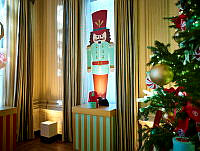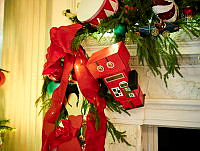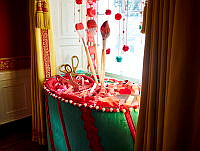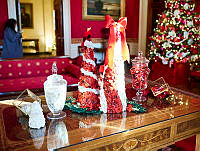Rubenstein Center Scholarship
Lou Hoover: Charity in the White House
Gallery
-

Lou Hoover with two Girl Scouts in 1931.
Library of Congress -

Lou Hoover distributes food baskets.
Library of Congress -

Herbert Hoover and Lou Hoover pose for a photograph.
Library of Congress -

The Hoovers host a garden party for disabled veterans.
Herbert Hoover Presidential Library and Museum/NARA
Following her death in 1944, one newspaper remarked that “Lou Henry Hoover’s life was a full, rich one, which has left its mark on the world.”1
Indeed, Lou Hoover’s extensive philanthropy improved the lives of many people. The scope of her work in charity, however, was not fully known to most Americans at the time, nor is it adequately acknowledged today. The first lady involved herself in charity work throughout her adult life, largely without publicity. Her commitments include a wide range of causes unified by several core convictions. Lou Hoover and her husband Herbert believed that relief efforts were most effective when performed on a local level, a principle that ultimately framed their charitable activities. Additionally, Lou Hoover’s love of the outdoors and her commitment to aiding young girls and women inspired much of her work.2
Lou Hoover’s benevolence was wide-reaching. During World War I, she contributed to Belgian relief, advocated for comfortable working conditions for female clerks in the Food Administration, collaborated with her husband on food conservation, and worked on a number of veterans’ issues. During and after the war, she worked on the Women’s Division of the National Amateur Athletic Federation, which promoted physical fitness. Hoover also was involved in the American Association of University Women, the Women’s Auxiliary of the American Institute of Mining and Metallurgical Engineers, and the American Red Cross.3

A young Lou Henry posing on a burro in Acton, California in 1891.
Herbert Hoover Presidential Library and Museum/NARALou Hoover’s most significant charitable commitment throughout her adult life, from 1922 until her death in 1944, was with the Girl Scouts of America, an organization that emphasized the importance of education and recreation for young girls. She served two terms as the president of the Girl Scouts, one before and one after her time in the White House. While she was the first lady, she continued to be active in the organization as an honorary president.4 Lou Hoover also organized and led Troop 8, meeting with them at the Hoovers’ Washington, D.C., residence and later at the White House itself.5
During the Great Depression that followed the stock market crash in October of 1929, Lou Hoover capitalized on her roles with the Girl Scouts and in the White House to respond to the crisis. She encouraged local Girl Scout troops to take up relief efforts in their communities. Girl Scout leaders met in 1931 at Camp Rapidan, President Hoover’s retreat in the Blue Ridge Mountains of Virginia, to lay out the details of this effort, which was accordingly referred to as the “Rapidan Plan.” In her remarks at the National Girl Scout convention broadcast on October 14, 1931, Hoover emphasized that “this is a year for us to take stock of the serious side of Girl Scouting, of its much encouraged ‘service.’”6 A newspaper reporting the event noted “that Girl Scouts can help in the depression of the coming winter by helping to keep girls in school and in scout troops, who are dropping out because of acute poverty, was one of the important points made in the convention. The need of bringing girls who are suffering from physical disabilities into the troops was also stressed.”7 During the Great Depression, Girl Scouts participated a variety of humanitarian work, such as aiding fellow troop members in need, serving in local breadlines, and collecting food and supplies for the destitute.8
Lou Hoover also furthered relief efforts through her role as first lady, undertaking what some have since called “stealth philanthropy.”9 Throughout her adult life, Lou Hoover made a practice of personally giving financial gifts, loans, food, and clothing to those who needed them. She funded the college careers of several young women who aimed to serve their communities.10 After her death in 1944, those cleaning out her desk drawer found many uncashed checks sent from people wanting to repay Mrs. Hoover the financial assistance that she had given them.11 Even her husband was surprised to discover the extent of her kindness to others. He said that she had aided in the education “of a multitude of boys and girls,” and called her “a symbol of everything wholesome in American life.”12

Lou Hoover, center, with American Red Cross workers in 1931.
Library of CongressLou Hoover’s personal charity grew and evolved as the Great Depression prompted more Americans to send letters directly to the first lady asking for assistance. Hoover and her staff developed a system to help them. They received so many letters that she employed and paid the salaries of three secretaries, unlike her direct predecessors, who had only employed one.13
Beginning in 1931, Hoover’s secretary Philippi Harding Butler managed the process of responding to letters asking for support. First, Hoover’s employees checked each request to make sure that it was legitimate. Most letters were then delegated to the appropriate local contact, either public or private, that would be able to best assist the letter-writer, although Hoover anonymously gave her own money to some. If the staff did not know of a local contact for a request, they would investigate further to find one.14
The first lady and her staff drew upon a large network of organizations, including women’s relief groups, local Red Cross chapters, local Girl Scout chapters, and the National Congress of Parents and Teachers. Additionally, the first lady and her staff occasionally consulted with the President’s Emergency Committee on Employment, later replaced by the President’s Organization on Unemployment Relief, and the General Federation of Women’s Clubs. These efforts were largely unknown to the general public, as Lou Hoover emphasized the confidentiality of those who wrote asking for assistance, and discouraged press coverage of this work.15

Lou Hoover in June 1924 in a crowd during her time as the President of the Girl Scouts of America.
Library of CongressIn addition to coordinating relief efforts, Lou and Herbert Hoover contributed to charitable projects. Their donations were integral to the establishment of a school near Camp Rapidan.16 The president befriended local 11-year-old Ray Burraker, and learned that he did not attend school because the region did not have one. The Hoovers spearheaded an effort to establish a school there. They and their staff alone contributed nearly $18,000 to the project. 17 The couple was closely involved in selecting Christine Vest as the teacher, and President Hoover and his secretary helped design the one-room schoolhouse.18 Lou Hoover assisted in selecting and purchasing textbooks and furniture for the school.19 She also purchased subscriptions to the New York Times and Washington Post for the students, and provided technology for the school to use, including a projector and educational films for students.20 Just as in many of Lou Hoover’s other philanthropic efforts, the couple generally discouraged media coverage of their efforts on behalf of the school.21
The “Mountain School” opened on February 24, 1930, and thirty-two students were enrolled by the spring of 1932. The school became a convening space for the entire community. Adult literacy classes were offered at night, and it was also used as a social space. In 1930, a newspaper commented on the school’s role in the community: “there’s not a person within several miles who hasn’t felt its influence.”22 The local community was appreciative of the Hoover’s efforts. On April 17, 1930, a group representing Mountain School students visited the White House to present a bolt of cloth, made by local women, to the first lady. It was intended to be used to make a suit for the president and an outfit for the first lady. The Hoovers continued to be involved in the school for remainder of the administration.23 Later, it was incorporated into the state school system. It operated until the federal government took over the land to create Shenandoah National Park.24
Lou Hoover’s philanthropic work was wide-reaching, both in terms of the breadth of organizations that she belonged to and in the effects of these charities. Despite the fact that Hoover’s charity work is little known to the general public, this first lady’s efforts show her commitment to improving the lives of others.






















































